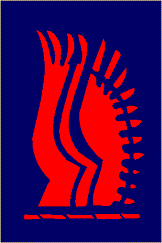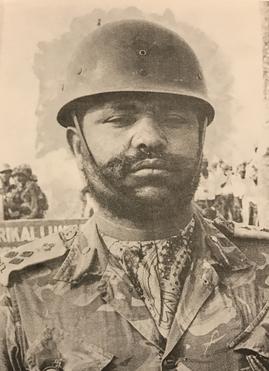
The Kenya Defence Forces (KDF) are the armed forces of the Republic of Kenya. They are made up of the Kenya Army, Kenya Navy, and Kenya Air Force. The current KDF was established, and its composition stipulated, in Article 241 of the 2010 Constitution of Kenya; it is governed by the KDF Act of 2012. Its main mission is the defence and protection of the sovereignty and territorial integrity of Kenya, recruitment to the KDF is done on yearly basis. The President of Kenya is the commander-in-chief of the KDF, and the Chief of Defence Forces is the highest-ranking military officer, and the principal military adviser to the President of Kenya.

The King's African Rifles (KAR) was a British Colonial Auxiliary Forces regiment raised from Britain's East African colonies in 1902. It primarily carried out internal security duties within these colonies along with military service elsewhere during the world wars and other conflicts, such as the Malayan Emergency and the Mau Mau uprising. The regiment's enlisted soldiers were drawn from the native Africans, while most officers were seconded from the British Army. During the 1960s, as part of the decolonisation of Africa, more African officers were commissioned into the regiment before it was gradually disbanded. KAR battalions would go on to form the core of newly established armed forces throughout East Africa.

The 1st (African) Division was a British Empire colonial unit during the Second World War. The division was formed on 24 July 1940 in East Africa. On 24 November of that year, the division was re-designated as the British Army's 11th (African) Division. The division were composed primarily of West African and East African troops. It was disbanded on 23 November 1941 and its component units reassigned.
The Rifles is an infantry regiment of the British Army. Formed in 2007, it consists of four Regular battalions and three Reserve battalions. Each Regular battalion of The Rifles was formerly an individual battalion of one of the two large regiments of the Light Division. Since formation, the regiment has been involved in combat operations in the later stages of the Iraq War and in the War in Afghanistan.

The 24th Infantry Brigade was an infantry brigade of the British Army from the First World War. It was reraised during the Second World War, as the 24th Infantry Brigade (Guards). During various designations, the brigade was active throughout the Cold War and existed until 1999, when it was merged with the 5 Airborne Brigade to become 16 Air Assault Brigade.
The Tanganyika Rifles was the sole regiment in the Tanganyikan army, from 1961 to 1964.

The 2nd (African) Division was a British Empire colonial unit that fought during the Second World War. On 19 July 1940, the 2nd (African) Division was formed in Kenya, British East Africa. On 24 November of that year, the division was redesignated as the British Army's 12th (African) Division. The 12th (African) Division was also known as the 12th Division when in October 1941 its West African brigade from the Gold Coast was reassigned and replaced with a third East African brigade. The division was disbanded in East Africa on 18 April 1943.

The 11th Infantry Division was a British infantry division consisting of troops from the British Colonial Auxiliary Forces which was formed in February 1943 during World War II. Consisting of East African troops, the division fought in the Burma campaign.

East Africa Command was a Command of the British Army. Until 1947 it was under the direct control of the Army Council and thereafter it became the responsibility of Middle East Command. It was disbanded on 11 December 1963, the day before Kenya became independent, and replaced by British Land Forces Kenya, tasked with withdrawing all remaining British troops. All remaining troops left by December 1964 and British Land Forces Kenya was disestablished.

The Kenya Army is the land arm of the Kenya Defence Forces.

The units of the Kenya Army Infantry are the principal fighting arms of the Kenya Army. The primary mission of the Infantry formations is to fight and win land battles within area of operational responsibilities in the defence of the nation against land – based aggression, while the secondary mission is the provision of aid and support to civil authorities in the maintenance of order. The Kenyan School of Infantry (SOI) is located in Isiolo County.

The involvement of the British Colony of Kenya in World War II began with the declaration of war on Nazi Germany by the British Empire in September 1939.

The British Army Training Unit Kenya (BATUK) is a training support unit of the British Army located in Kenya.
David Bugozi Musuguri is a Tanzanian soldier and retired military officer who served as Chief of the Tanzania People's Defence Force from 1980 until 1988.

John Butler Walden was a Tanzanian military officer. Born in British Tanganyika to a white father and black mother, he enlisted in the King's African Rifles in 1957 after finishing school. He eventually achieved the rank of sergeant and, following Tanganyika's independence, was transferred to the Tanganyika Rifles. In April 1963 he became a lieutenant. He was later promoted to major and held command of a camp in Mafinga. During the Uganda–Tanzania War of 1978 and 1979 Walden served as commander of the 207th Brigade in the Tanzania People's Defence Force with the rank of brigadier. In 1981 he organised the withdrawal of the Tanzanian troops in Uganda. By 1987 he had been promoted to major general and two years later he oversaw an anti-poaching operation. He died in 2002.
The Uganda Army, also known as the Uganda Rifles, served as the national armed forces of Uganda during the presidencies of Mutesa II and Milton Obote. As time went on, the military was gradually expanded and increasingly interfered in Uganda's national politics. It played a prominent role in defeating local insurgencies, suppressing opposition to Obote, and intervened in conflicts in the Congo as well as Sudan. Dissatisfied soldiers overthrew Obote in 1971, resulting in the establishment of the Second Republic of Uganda under the dictatorship of army commander Idi Amin. The Uganda Army was purged, with thousands of suspected pro-Obote troops killed or fleeing the country. The military was consequently split into an army serving under Amin – the Uganda Army (1971–1980) – and exiled rebel factions. The latter helped to overthrow Amin's regime during the Uganda–Tanzania War of 1978–79, and became the core of the Uganda National Liberation Army which would serve as Uganda's national military from 1980 to 1986.
The 21st Infantry Brigade was a brigade sized formation of the British Army, which was founded on 31 August 1939 in British East Africa. The brigade was initially called the 1st Infantry Brigade, but was redesignated on 18 October 1940 as the 21st Infantry Brigade. The brigade was composed of units from the King's African Rifles and the Northern Rhodesia Regiment.
The 22nd Infantry Brigade was a brigade sized formation of the British Army, which was founded on 19 September 1939 at Colito Barracks in Dar es Salaam in British East Africa. The brigade was initially called the 2nd Infantry Brigade, but was redesignated on 18 October 1940 as the 22nd Infantry Brigade. The brigade was composed of units from the King's African Rifles, the Northern Rhodesia Regiment and the Rhodesian African Rifles.
The 25th Infantry Brigade was a brigade sized formation of the British Army, which was founded on 11 October 1940 in British East Africa. The brigade was initially called the 5th Infantry Brigade, but was redesignated on 18 October 1940 as the 25th Infantry Brigade. The brigade was composed of units from the King's African Rifles.
Lugalo Military Camp is a large installation of the Tanzania People's Defence Force located in the city of Dar es Salaam along the Bagamoyo Road.












